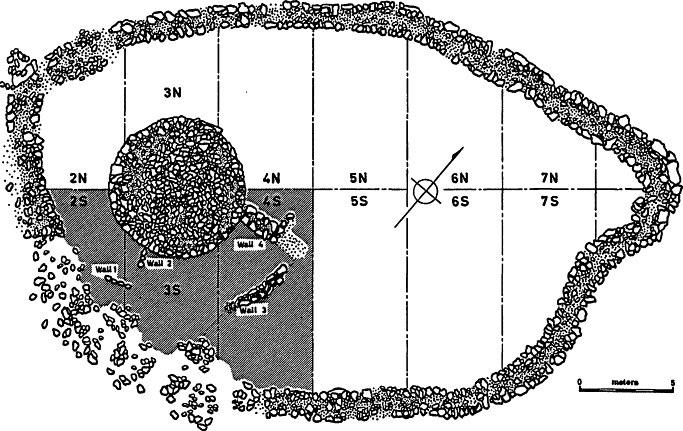The Tower Enclosure
The Dema tower is surrounded by a low enclosure wall that traces an elliptical course, with irregularities on its eastern and western ends where the enclosure wall bends to incorporate bedrock outcrops into its line. The tower sits on the highest ground, near the southwestern end of the enclosure, while the largest open area within the enclosure is the gently sloping ground northeast of the tower. The interior of the enclosure, like most of this limestone hill, is rocky and uneven, with few level areas. The enclosure wall is built of roughly laid limestone rubble, with traces of its inner and outer faces preserved for most of its circumference. Only in one area, on the southern side of the enclosure (bounding areas 2S, 3S, and 4S in map 4), is the rubble so sparse that no trace of either face can be followed. The width of the wall varies from 1.20 to 1.80 meters, and it stands today to a height of 0.60 meters at its highest points. It probably was never very much higher than this, since only a

Map 4.
The Dema tower
small number of stones lie loose around it. No trace of an entrance through the wall is to be found.
Inspection before excavation revealed no evidence for ancient subsidiary structures within the enclosure.[4] The only artifacts to be found were fragments of Lakonian-type roof tiles, scattered throughout the enclosure, but more abundant close to the tower. Excavation within the enclosure was undertaken in an effort to discover datable occupation debris and to ascertain whether or not there were any subsidiary structures associated with the tower. The area immediately south and east of the tower seemed to be the most promising quarter for investigation, since it was generally covered with a layer of rubble that might preserve features or artifacts beneath it, and the ground here was more nearly level than elsewhere in the enclosure (figures 25, 26). The area immediately north and west of the tower had less rubble cover, and here sterile bedrock could be seen over much of the area. The numerous jagged bedrock outcrops in the open area northeast of the tower made this section seem less likely to yield occupation debris. Work was thus directed toward clearing the rubble and excavating in the areas labeled 2S, 3S, and 4S in map 4.[5]